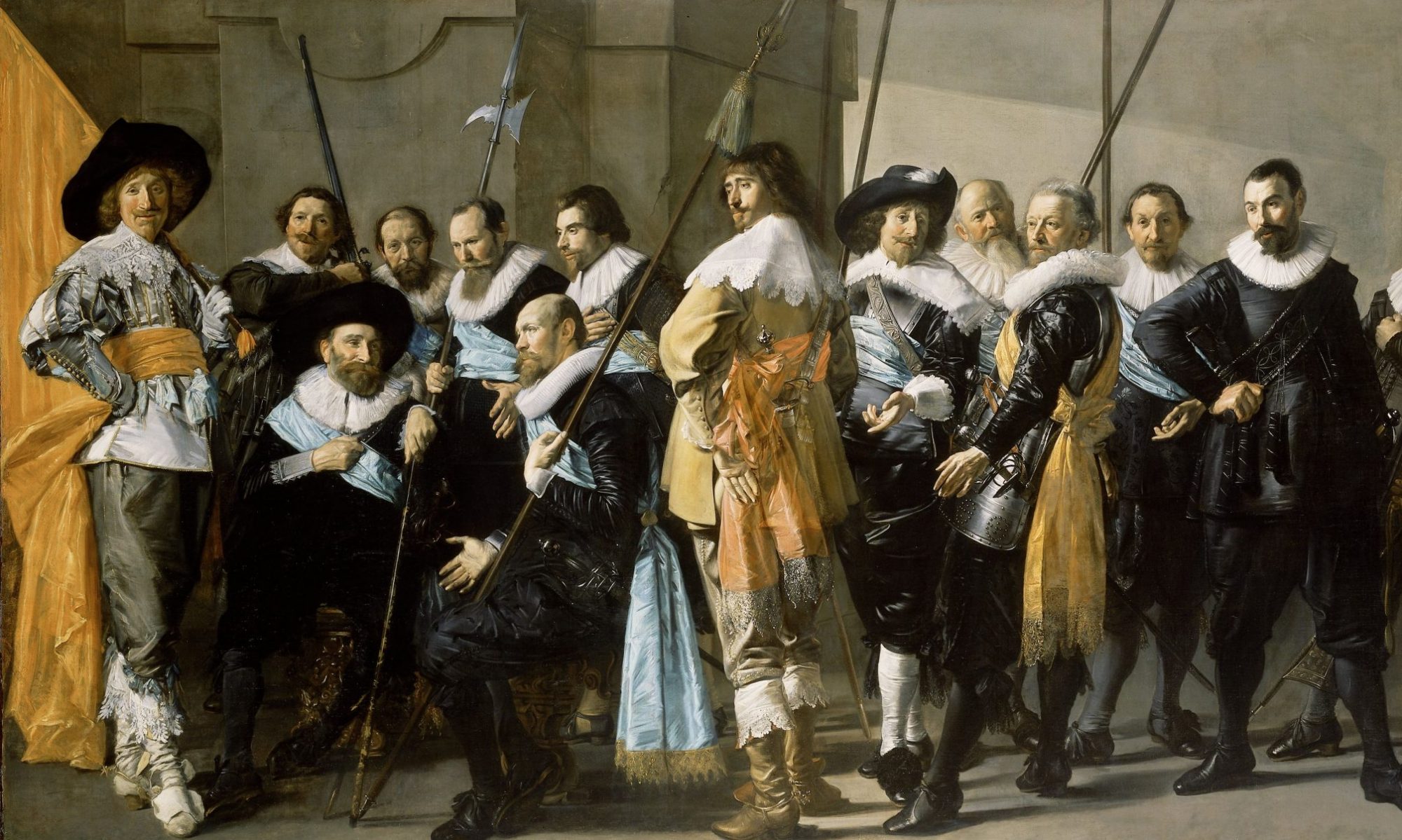dr. Raffaele Longo. Conservatorio di Musica Stanislao Giacomantonio, Cosenza, Italia.
Abstract: Any discussion of C., of its stylistic features – musical and dramatic – risks, in fact, slipping into musical theatre itself , risks destroying the plot and the action. In the final analysis it risks speaking about a work the objective of which is the theatre that puts itself on show. Così fan tutte only finds, perhaps, its deeper meaning inside the space of the dramaturgic lie. The representation of a canonical theatrical object is not the core of the dramaturgy of Così fan tutte. The authentic core is the ‘canon’ itself: the rule of the game is the authentic scenic object of the opera. The semiotic and deconstructive approach to Mozart’s masterpiece, risks going beyond the music analysis. It goes on to pose more general questions: those linked to the legitimacy of semantics in music. This work documents, basically, the attempt to answer such questions.
Keywords: deconstruction, dramaturgy, music analysis, narratology, interpretation, semiotics.
Dramaturgia zhyhania. Analýza a lož v Mozartovej opere Così fan tutte
dr. Raffaele Longo. Conservatorio di Musica Stanislao Giacomantonio, Cosenza, Italia.
Abstrakt: Akoukoľvek diskusiou o opere Così fan tutte a jej štylistických znakoch – hudobných a dramatických – riskujete vlastne skĺznutie do samotného hudobného divadla, riskujete zničenie zápletky a deja. V konečnom dôsledku hrozí, že sa bude hovoriť o diele, ktorého cieľom je divadlo, ktoré samo seba vystavuje na obdiv. Così fan tutte nachádza svoj hlbší zmysel možno len v priestore dramaturgickej lži. Zobrazenie kanonického divadelného objektu nie je jadrom dramaturgie Così fan tutte. tutte. Autentickým jadrom je samotný „kánon“: pravidlom hry je autentický scénický objekt opery. Semiotický a dekonštruktívny prístup k Mozartovmu majstrovskému dielu, riskuje, že prekročí rámec hudobnej analýzy. Pokračuje v kladení všeobecnejších otázok: otázok spojených s legitimitou sémantiky v hudbe. Táto práca v podstate dokumentuje pokus o zodpovedanie takýchto otázok.
Kľúčové slová: dekonštrukcia, dramaturgia, hudobná analýza, naratológia, interpretácia, semiotika
The present essay and all musical examples are based on the book of the author The dramaturgy of failure, published by the University of Salerno, Department of Medieval and Latinitas, Collection „Schola Salernitana – Studies and Texts“, with the Editions Laveglia, Naples, 2004.
Così fan tutte, ossia La scuola degli amanti
(Thus Do They All, or The School For Lovers), K.588.
Is a comic opera by Wolfgang Amadeus Mozart. The libretto was written by Lorenzo Da Ponte. The title is often shortened to Così in the English-speaking world. The title, Così fan tutte, literally means „Thus do all [women]“ but it is often translated as „Women are like that“. The words are sung by Don Alfonso in Act II, Scene XIII, just before the Finale. The other two Da Ponte-Mozart collaborations were The Marriage of Figaro and Don Giovanni. Così, based on a fact really happened in Trieste, was written and composed at the suggestion of the Emperor Joseph II. The first performance of Mozart’s composition took place at the Burgtheater in Vienna on January 26, 1790.
The dramaturgy of failure.
Analysis and lie in Così fan tutte of Mozart
Why Così fan tutte? For a very simple reason: to investigate the causes of a misunderstood reception. The story of Così fan tutte and its public is one of a difficult relationship, of a reception that was very different from that of the other masterpieces of Mozart e.g The Marriage of Figaro or Don Giovanni. It is true that there was no aria, motif or theme of Così fan tutte that the public could easily remember, even after repeated hearings. It is also true that the ‘canto’ (song) in Così fan tutte doesn’t seem to ‘fly high’ but seems, on the contrary, not to have the typical flights of Mozart. Tiredness? Distraction? These hypotheses seem fragile: in those same years Mozart’s creativity was unrivalled. But, if it were another quality of song? If it were a melodic texture, created intentionally to hide something else? The true object, for example, of opera? Is Mozart, while pretending to tell us an intriguing story of unfaithfulness, lying to us and really speaking about another matter? What is this other hidden narrative aliquid? In this way the dramaturgy of Così fan tutte would take life from the tale of a lost object.
What?
The theatre itself and its functioning mechanisms. Any discussion of Così fan tutte, of its stylistic features – musical and dramatic – risks, in fact, slipping up on the fact that here opera puts itself onstage, and risks destroying the plot, and with it, the action. In Così fan tutte there isn’t the scene, there is only the reverberation of this, as in a photo frame, or the frame of a painting by Velázquez. Mozart could conceive only one time – what else does the plot of Così fan tutte narrate if not about a siege and a capitulation: uncovering this was only possible by lying. About the story of his characters or about the time on the scene. Indifferently.
Così fan tutte only finds, perhaps, its deeper meaning inside the space of the dramaturgic lie. Continuing to lie (the true tale). Lying to fail (in the dramaturgic sense). Failing to exist, as scenic object. And to show, unsuspectingly, a reality that fascinates and destabilizes. The representation of a canonical theatrical object is not the core of the dramaturgy of Così fan tutte. The authentic core is the ‘canon’ itself: the rule of the game is the authentic scenic object of the opera. The semiotic and deconstructive approach to Mozart’s masterpiece, risks going beyond the music analysis. It goes on to pose more general questions: those linked to the legitimacy of semantics in music. This work documents, basically, the attempt to answer such questions.
Now two methodological clarifications.First. I used two very different research methods to approach Mozart’s text: deconstruction and Schenkerian analysis.
Second. The use of Schenkerian analysis here is only functional, to support and demonstrate the systematic semiosis of Mozart’s masterpiece.
The death of Procris
The dramaturgy of the lie
Beyond the stage: time negated
Perhaps the dramaturgy of Così fan tutte is nothing more than the story of a lost object. Any discussion of C., of its stylistic features – musical and dramatic – risks, in fact, slipping into musical theatre itself , risks destroying the plot and the action. In the final analysis it risks speaking about a work the objective of which is the theatre that puts itself on show. We believe this reasons for this loss arise from the choice of using a text whose genetic nucleus is a myth: the implications of the episode involving Cephalus and Procris1 told in Ovid’s Metamorphosis. The parallelism between the tale of Ovid and Così is surprising:
| Ovid’s myth | Opera buffa (Comic opera) |
| Aurora (Eos), angry, menaces Cephalus | Don Alfonso insinuates doubt |
| The goddess changes the Appearance of Cephalus | Farce of disguise |
| The first approach to Procris fails | The first ‘attack’ fails |
| Procris succumbs (for one night) | The tale of a successful siege |
| Repentance of Procris | « Thus do they all! » |
| The death of Procris for a ‘name without body’ | Life of artwork: absent object (lie) |
What is dramatic quintessence? Is the dramatic quintessence the attempt to make coincide, through the characters, the time of the tale (mythical, in this case) and the time of listening and, then, the time of the other story, that which is transmitted from the text to the physicality of the characters on stage? So it seems that Così fails in this aim.
Why?
Because Così is not a play with a plot which is really possible; in Così we are in front of an archetype, and the archetype is opposed, by its nature, to deferment2 or, what is the same, is only made to reappear in endless deferments.
Ovid’s myth blocks whichever plot develops, only allowing metaphoric changes, beyond the sintagmatic structure, and strongly influences the dramaturgic outcome.
We follow, in this way, the story of an identity: in love affairs, all women behave in the same way. We are watching a plot where we already know the infallible outcome.
In the beginning there is a title which polarizes, in its own semantic structure, a very fast narrative sequence:
they will betray
they betray
they have betrayed
In the end – but is it really it an end? – there is a speaker (Don Alfonso) who declares the women’s unfaithfulness.
Don Alfonso: the ‘speaker’
With this term I mean the role of Don Alfonso that demarcates, in Così, the theatrical time, that is the attempt to make to the time of the story and the time of listening on the part of the performers coincide, and, after, the time of the other story that isn’t of the text but of the bodies of the performers, who play, sing and mime it on the stage.
It is Don Alfonso who restarts, on the stage, that “other” voice, the original one, that is the myth.
The Sources of Così fan tutte:
Ovid’s Metamorphoses (VII), the myth of Cephalus and Procris.
Boccaccio’s Decameron (2nd day, IX novel)
Ariosto’s Orlando Furioso (XLIII)
and, of course,
The Commedia dell’Arte
There is a very clear dramaturgic choice: Mozart and Da Ponte restart in the core of the play the gallant movements of an archetypal Commedia dell’Arte and they voluntarily expose the dramatic structure. In other words, Così fan tutte tells us about an original skirmish “of three”, where a cynical Harlequin acted as killjoy between an anxious Pierrot and easy Columbine.
The “dramatic geometry”
This is the scheme of the basic plot of an “demonstration (educational) play”.
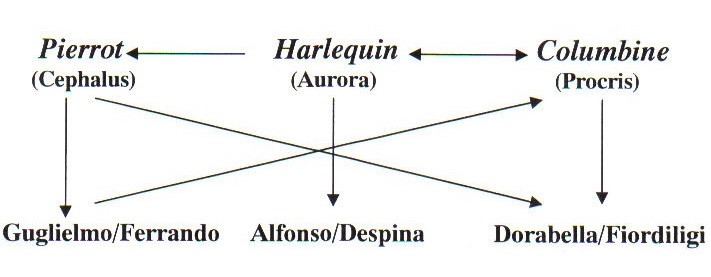
This theatre of puppets, that pedagogically uses dramaturgic types more then characters
+
The theatre created from the play script that Don Alfonso (with the help of Despina) plots to the detriment of the two officers
+
The quintessence of the theatre that connects the «space of the theatricality» to the «space of the theatre»
THE THEATRE WHITHIN THEATRE

So we find out Così fan tutte tells us about the theatre itself, rather than female levitas animi. In the final analysis this is the fundamental role of the myth.
The symmetrical structure
- motto3 at the beginning and end of the opera

Ouverture. In fact is it on this motif that Don Alfonso will pronounce, in his final Andante, the motto: «All women are like that!»:

2. ensembles with characters treated “in couples”
3. parallelism of the “places” of seduction (duets 23, F major, and 29, A major), both in the same tonality as the opening and closing motto:
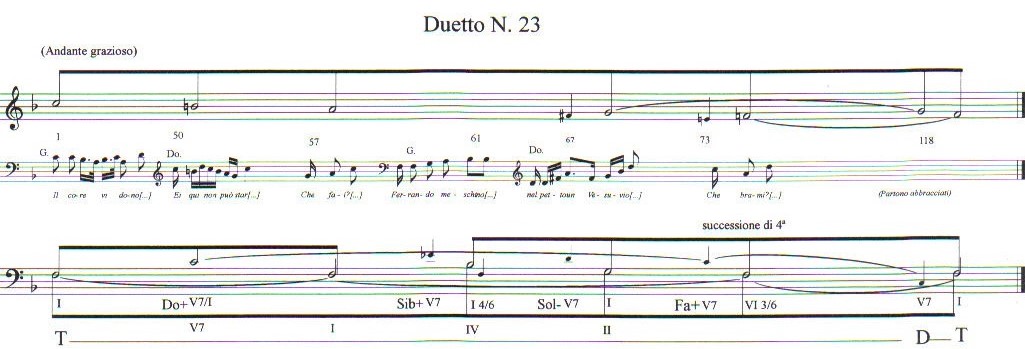
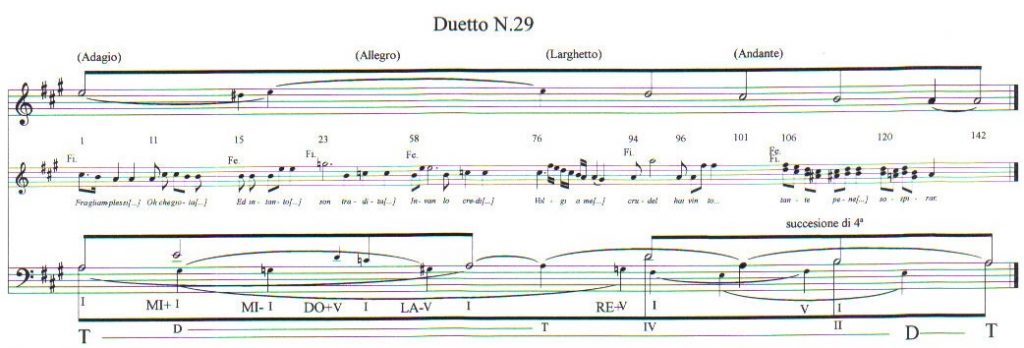
4. symmetrical distribution of the arias: two for each character (with the exception of Ferrando, who sings three arias)
5. absolute prevalence of the ensemble forms, unique in the theatrical production of Mozart.
Let’s look at the dramatic architecture of Così fan tutte: note the clear predominance of the ensemble pieces.
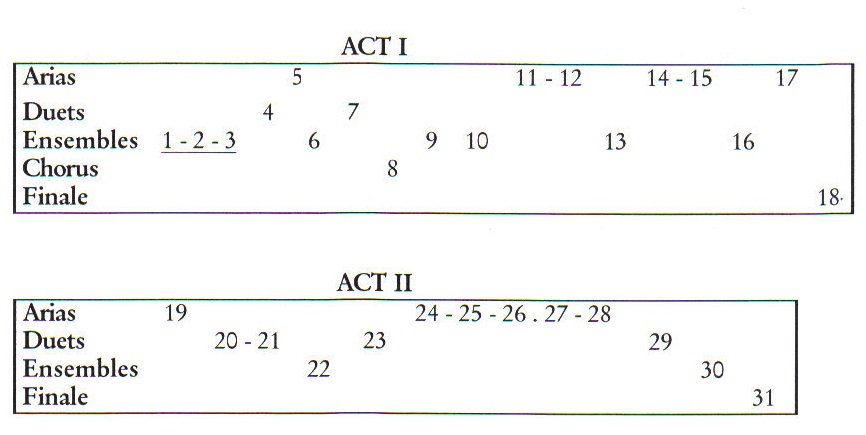
The dramaturgic metalanguage: or time negated
A meta-plot, firstly, of which the single stage time is traced, in the myth, obscenely (o-skenè: off stage). It is in this that the meta- theatricality of Così fan tutte exists. A play which has lost its object and that tells of a nonexistence: that space of the speaker which demarcates a possible scene and, with it, the time of the theatre.
A meta-sound (meta-phoné), consequently which originates in the original materials (genetic: mythical) of the tonal language.
The time of Così fan tutte lives in the sound material that, original, always remain identical to itself, in continuous projections, redeployments, deferments.
A dramatic dissemination becomes pure musical movement, indifferent to the physicality of the characters.
So the sound space of Così fan tutte does not refer to other times but to its own time, unrelated to all possible time deferments.
If betray (= ‘give beyond’) means entrust to another, so the authentic representation of the betrayal will be somewhere else.
Where?
In the ‘other’ temporal places (with respect to the stage) of the myth. We have seen this.
But it also means that Così fan tutte, losing own stage objective, fails the premise.
In the absence (of theatrical time) the stage is lost here, the first time, like a theatrical object.
Beyond time: concerting space
Orchestrating the scenic destiny of archetypal puppets was difficult, even for Mozart’s unlimited imagination. To breathe life into his puppets Mozart returned to the origins of tonal language.
The meta-plot, again…
In Così fan tutte the Overture is the origin of the movement of sound. The listener already knows the end of the story.
So, why does Mozart produce the motif immediately at the beginning the opera?

And immediately finishing the narrative order?
Overcoming the myth was possible, but only by screening itself, and immediately projecting in scene, beyond its own language, the language of the music itself.
The ghost of Mozart
I compose. Or: I follow an idea – dramaturgic and musical – while I remain completely indifferent to the media for making it.
I omit. I omit the theatrical destiny of my “objects”, that cease to exist as protagonists of the drama and I use them, intentionally, as media of a great dramatic plan.
I push the characters to the periphery, while I focus my imagination and my harmonic and contrapuntal science on the creation of a “phonic mass” in movement – the movement as action.
This will be the real protagonist of the opera.
This is perhaps the theatrical ghost chased by Mozart.
What else are the notes of the motif if not the original components of tonality: tonic / subdominant / dominant?

The ring I
The musical material of the motif will condition the whole of Così fan tutte.
There is a circular connection for the choice of putting a motif showing the basis of tonal language immediately at the beginning of the opera.
On the one hand, there is the risk of listening repeatedly to a single sound sign, with only a few variations the same nucleus of the narrative, that our memory projects, perhaps unintentionally, on the original motif (motto), as in a virtual coexistence made by the associative processes.
On the other hand, the opposite process is also true: the possibility of projecting the virtual infinity of thematic creations – all potentially contained in the original linguistic elements – to the sound archetype made by the fundamental tonal linguistic horizon.
Così fan tutte runs this risk. And with it, any discussion of the masterpiece: when we consider Così we are considering theatre itself.
In absentia…
This is the cause if in looking at Così we can see the same structures as in the process of composition:
- The unique ‘deep’ modulations in the Overture, those that are long term, are in subdominant and dominant.
- the beginnings of almost all motifs of the opera are on a fourth: D-T
- latent presence (in the absence) of the motto:

in the long-term dramaturgic connections (texture and harmony):
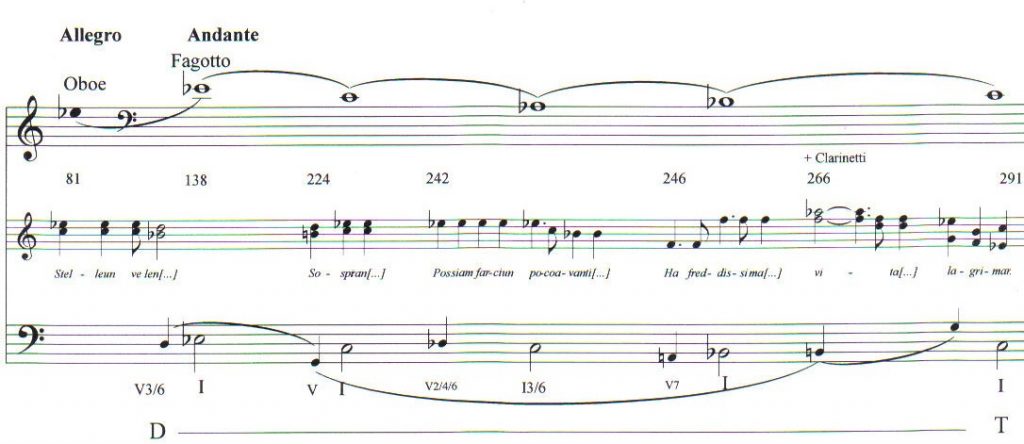


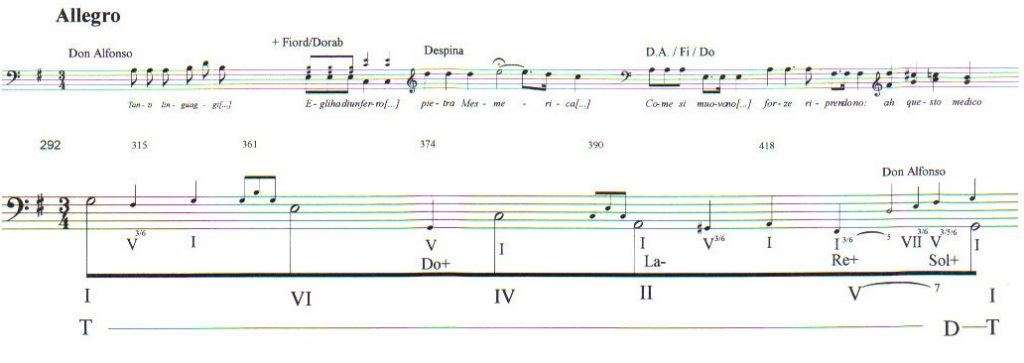
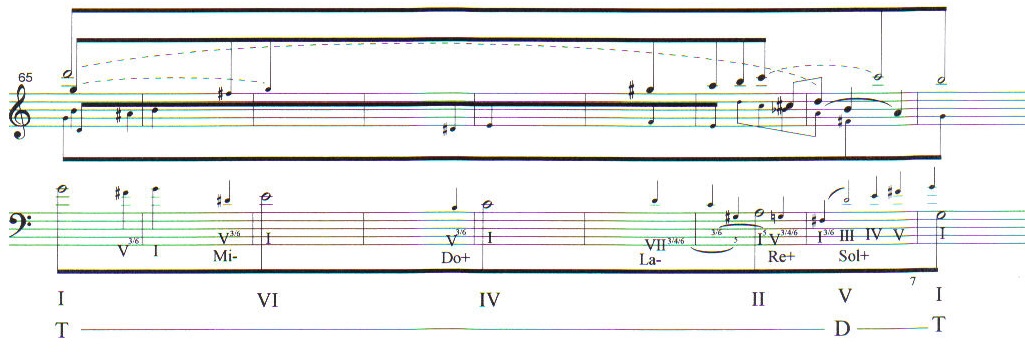
The bipolar structure
The role of the Ouvertura
Only fourteen bars: trying for and affirming a tonal space. Nothing new in this. At the 15th bar the Presto starts.
We are in full musical rhetoric: slow – fast
But after 231 bars the sound whirlwind is suddenly interrupted, stopping on the motif:

We have this structural scheme
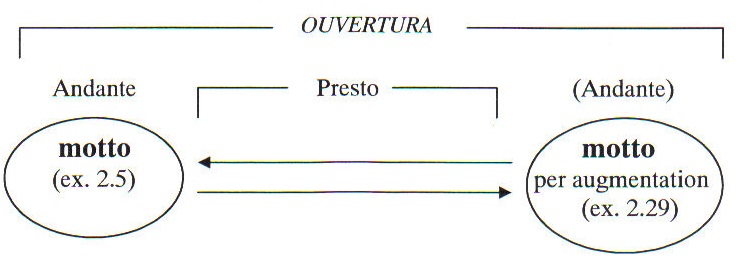
And the time?
Is it that of the music? Of the scene?
And, finally, of the drama?
The Presto seems to make a temporal dialectic.
But if we look into the deeper structure of the Overture, we find the whole Presto is a great dilation of the motto.
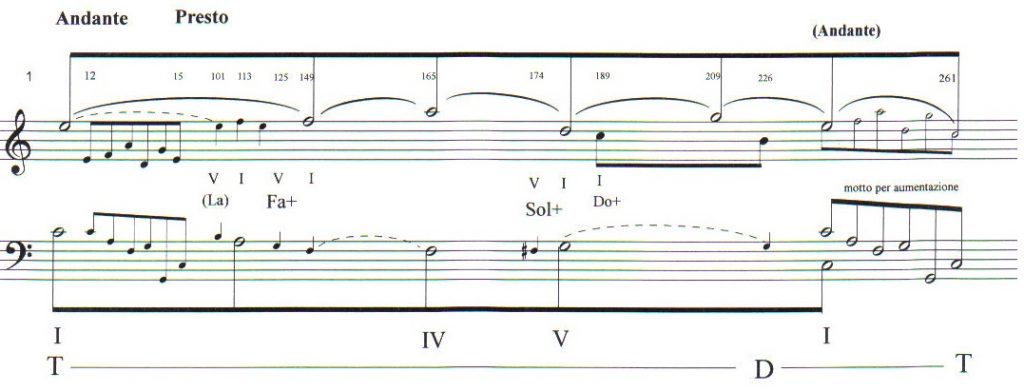
Phonic on stage
Here there is only one time: that organic one of an original sound matter creating, only by its movement of expansion, its own sound space. Here any temporal dialectic between slow (Andante) and fast (Allegro) is denied. There is no scene, only the reflection of it, as in a photo frame, or in the Velázquez ’s painting. Here Così fan tutte loses, for a second time, its object: the time of the sound representation.
Now let’s look at the overall architecture of Così fan tutte.
It is revealed as a gigantic projection of the bipolar structure that we have just shown. At the beginning: the ‘Ouvertura’ At the end: a failed ‘trio’.
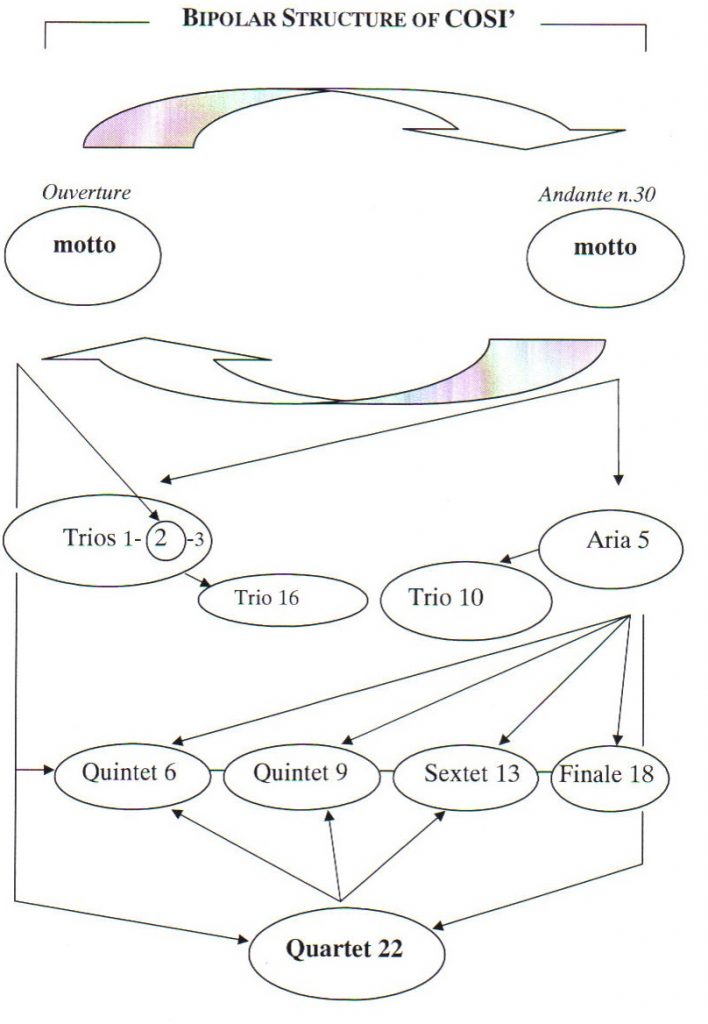
Forms of multiplication (Opera out of Opera) of the sound (and dramaturgic) space, or forms of phonic (and scenic) dilation, watched with overturned binoculars.
The ring II
This is the circular dramaturgy of Così:
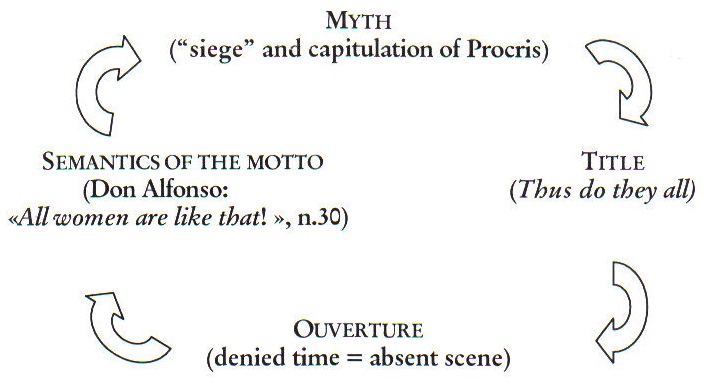
At the deeper dramaturgic level this scheme summarizes the complex scenic structure of Così
Mise en abîme
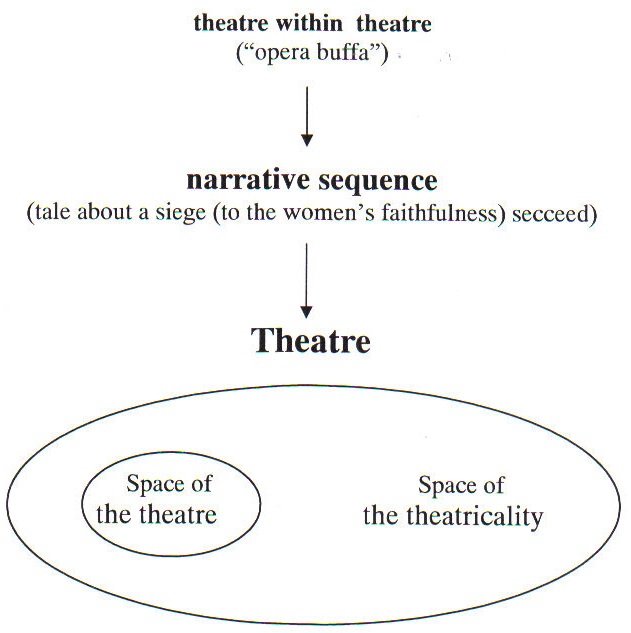
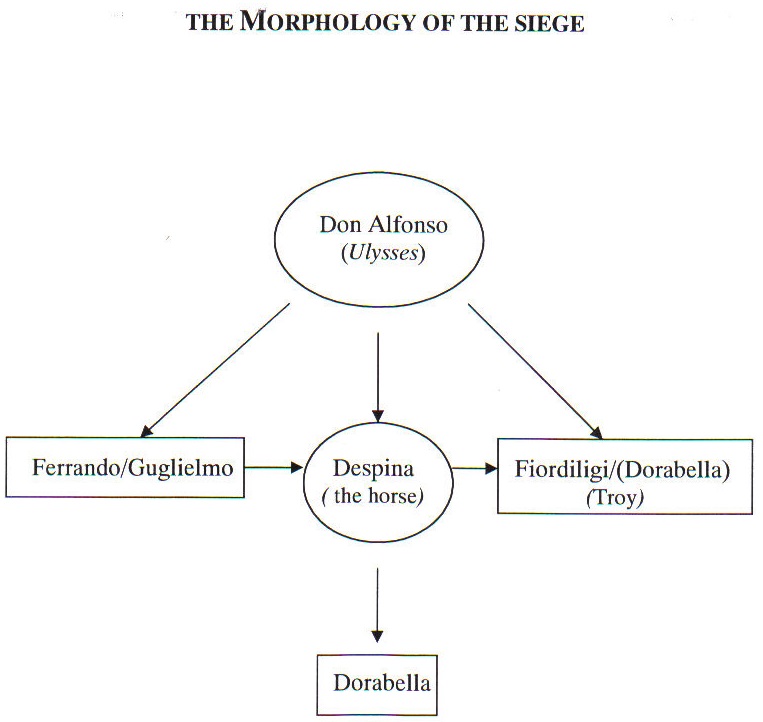
And we know that the siege succeeds through deceit:
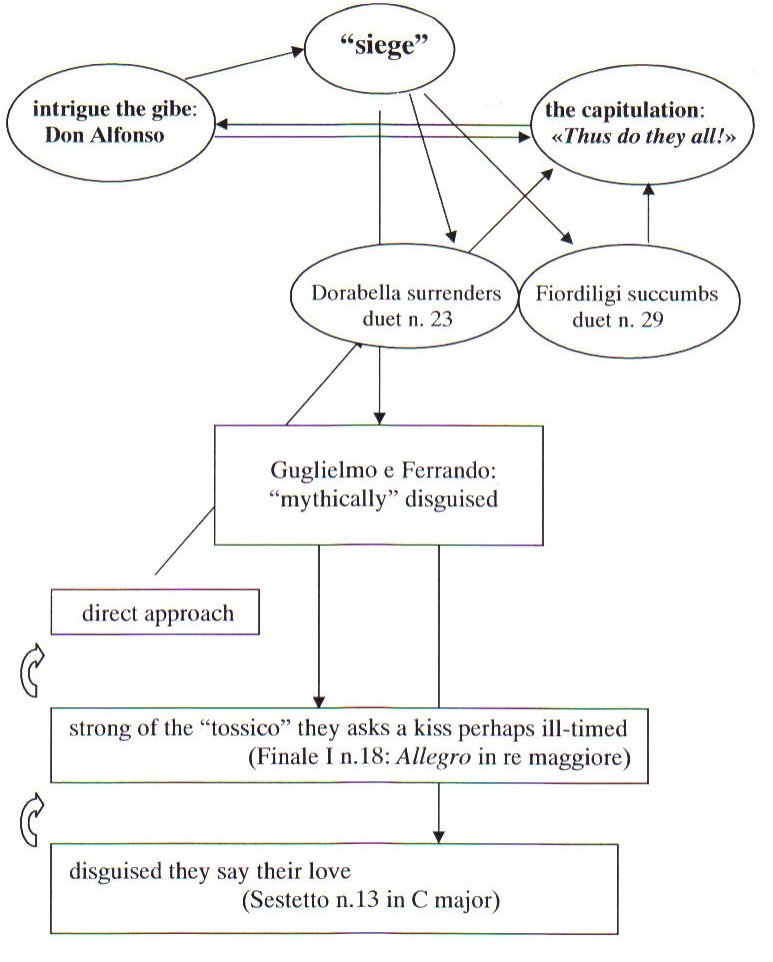
Again an origin.
Again the myth.
Again a possible restart.
The siege is a wait (in time)
In the siege there is only a dialectic of spaces.
Time is immobile.
The scene is without any apparent life.
Again as in a frame.
Again as in Las Meninas.
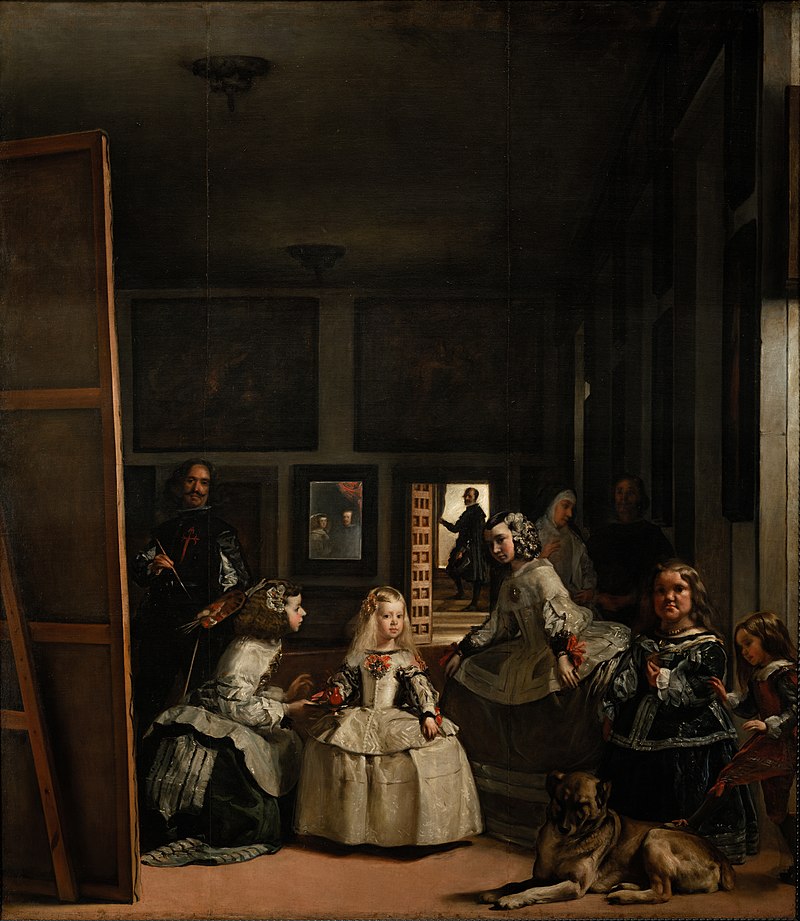
That one scene that restarts at every moment the same game. Again, finally, as in a game of chess4.

When the realistic time of the plot arrives, Così fan tutte is already near the end (Finale II, No. 31). As in the Overture, where after the second appearance of the motto there is only the space of a very fast ending: only 20 bars of a total of 261!
The quartet
The only quartet of Così fan tutte tells us about a failed, again, ensemble. Let’s look at the scene. We are in the second Act.
Change.
Garden at the seaside with grass seats and two stone tables.
Flower bedecked boat, with band.
Despina, Ferrando and Guglielmo.
Servants well dressed.
Chorus of musicians.
(After Fiordiligi, Dorabella and Don Alfonso)
So, a crowded scene.
But not the scene of the sound dramaturgy.
During the quartet Dorabella and Fiordiligi stay in silence, in the arms of Don Alfonso and Despina. And our two disguised puppets?
During the whole quartet (91 bars), they sing for only 10 measures.
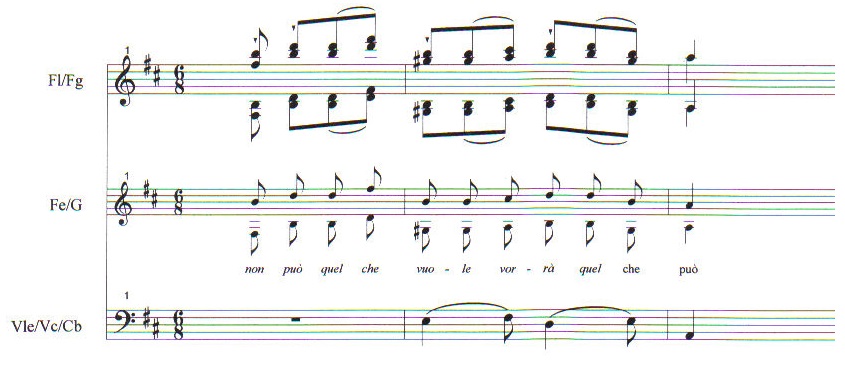
From a failed concerted piece to a highly successful dramaturgic structure.
Also in the last terzetto (again failed), Andante n.30, Guglielmo and Ferrando are pushed to the periphery of the sound scene:
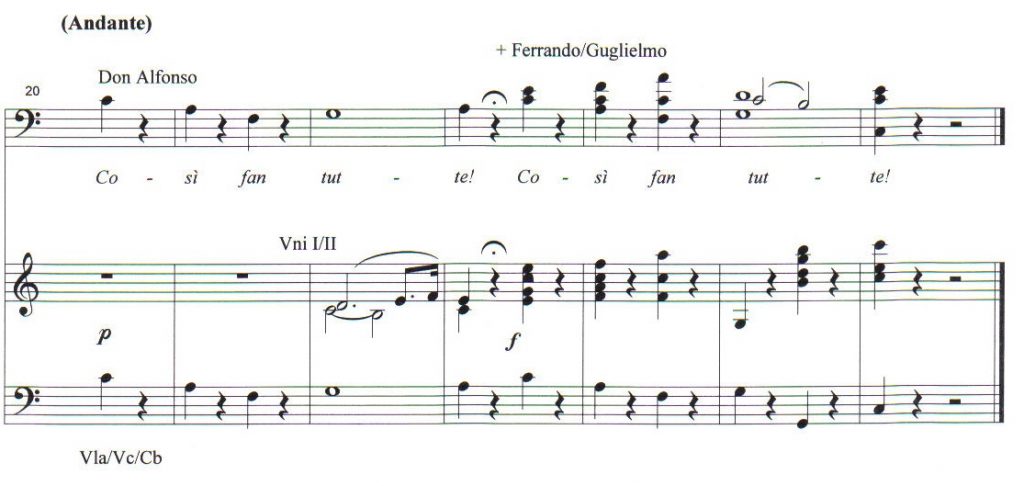
And in fact the harmonic structure of the final Presto of the Quartet really corresponds to the tonal structure of the last Andante (n.30) in C major:
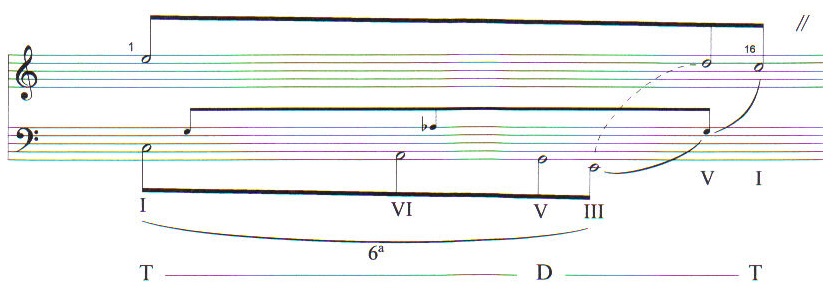
this sequence:
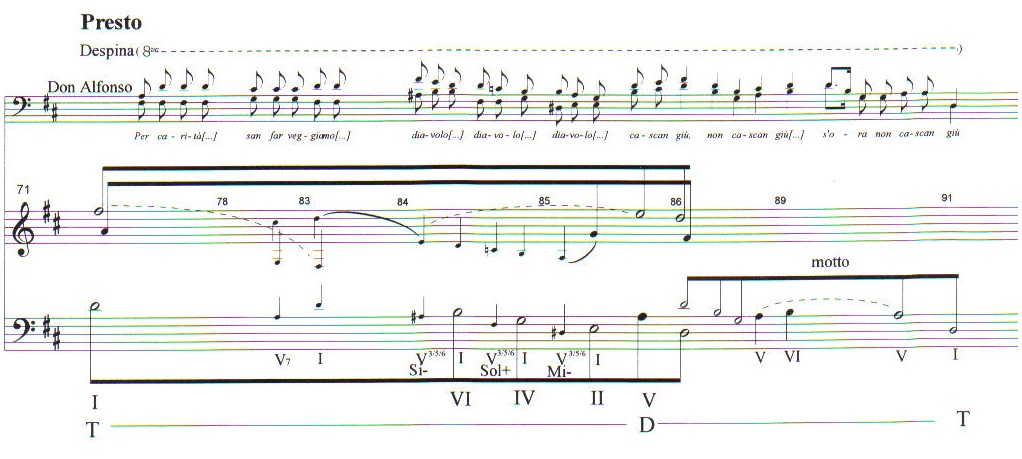
is forever crystallized, on the other hand, in an already heard harmonic path:

Theatre of Paper
Don Alfonso: the dramaturgic “puppeteer”
In his last Andante (N. 30), Don Alfonso pushes the two puppets in love to the edges. Here the drama crashes, while the motto shows itself to be the real semantic key of Così fan tutte.
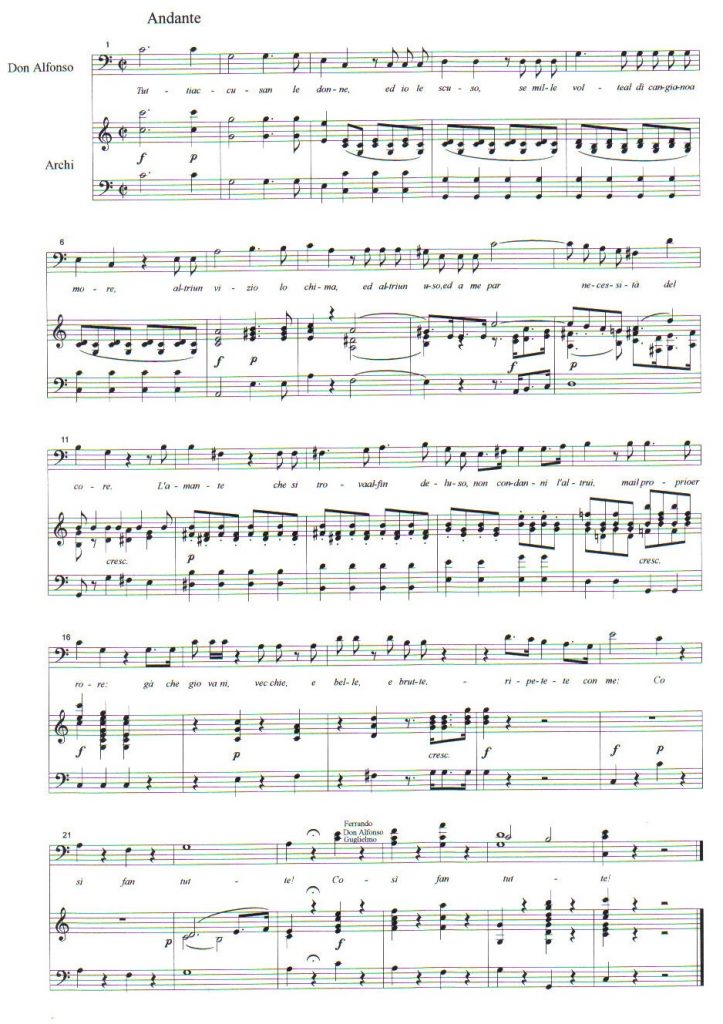
The marginality, that the paper lovers suffer, pushes the forms of the sound play to centre stage. That is, now, a game of endless re-presentations (replays). A game which puts itself on show: forms of marginal theatre cropped in the staff. «Theatre of paper» to be reread beyond the problematic put on in the play. Mozart could conceive only one time – like that of a frame: discovering this was possible only by lying. About the story of his characters or about the time of the scene. Indifferently.
The lie as (dramaturgic) truth
We are again, circularly, among the semantic spirals of the myth. It was a name without a body which destroyed the happiness of Cephalus forever. The same fatal ‘Aura’ bears here as on the pierced body of Procris.
Only in the space of the dramaturgic lie is it perhaps possible find the deeper scenic meaning of Così fan tutte:



Continue to deny. Deny to live (as scenic object). The obscene Così fan tutte so loses, for the third time, its object (the theatrical scene). But it also displays, unsuspectingly, its own destabilizing and fascinating actuality.
Summary
Why Così fan tutte? For one very simple reason: to investigate the reasons for a misunderstood reception. Così fan tutte and its audience are the story of a difficult relationship, made up of non-enthusiastic and not immediate receptions, far from those reserved for other masterpieces by Mozart, works such as Le nozze di Figaro or Don Giovanni, for example, which were also born from the collaboration with Da Ponte. It is true that there is no aria, motif or theme in the opera that easily remains impressed in the auditory memory, even after repeated listening. It is also true that the singing in Così fan tutte does not seem to ‚fly high‘, it seems to lose its typically Mozartian sprinting and soaring. Tiredness? Distraction? Untenable hypotheses, if in those same years the creativity of the genius from Salzburg continued to demonstrate a melos that proved to be incomparable. But – and here is the thesis of the book – what if it is another quality of singing? What if it is a melodic fabric created to intentionally conceal something else from us? The authentic object, perhaps, of the work? What if Mozart, pretending to tell us an intriguing story of betrayal, was lying to us, telling us something else? Only to discover that this hidden narrative aliquid would turn out to be the theatre itself and its operating mechanisms? The dramaturgy of Così fan tutte would thus come to life from the narration of a lost object. Any discussion of Così fan tutte, of its musical and dramatic stylistic features, risks unintentionally slipping into (musical) theatre staging itself, risks destroying the plot and, with it, the action. The scene is missing in Così fan tutte, there is only the reverberation of it, as in the borders of a photographic frame or in the frame of a Velázquez painting. A single motionless time – what else does the plot tell us if not of a siege and a surrender? – was conceivable for Mozart: finding it was only possible if one lied. Either about the history of his characters or about the time of the stage. Indifferently. In the space of the dramaturgical lie alone, this masterpiece perhaps rediscovers its deepest scenic sense. To continue to deny (the true story). To deny in order to fail (dramaturgically). To fail in order to exist, as a scenic object. And to exhibit, unsuspectedly, a fascinating, destabilising topicality.
Bibliography
ABERT, H., Mozart, Wiesbaden, Breitkopf & Härtel, 1955-66, 2 voll.; ediz. it. a cura di P. Gallarati, Milano, Il Saggiatore, 1984-86, (1ª ediz. Il Saggiatore Economici, 1995), vol. II, La maturità.1783-1791, pp. 547-87.
AIELLO, E., Carlo Goldoni. Leggere il teatro, introduzione a C. Goldoni Il Teatro Comico e altri scritti teatrali, a cura di E. Aiello, Roma, Archivio Guido Izzi, 1992.
ARIOSTO, L., Orlando Furioso, a cura di S. De Benedetti e C. Segre, Bologna, 1960.
BARONI, M., La musica dall’Illuminismo al Romanticismo, in Mario Baroni “e altri” Storia della musica, Torino, Einaudi, 1995, pp. 223-39.
BARTHES, R., Elementi di semiologia, trad. it. di Andrea Bonomi, Torino, Einaudi, 1966.
BARTHES, R., La retorica antica, trad. it. di Paolo Fabbri, Milano, Bompiani, 1972.
BARTHES, R., Il piacere del testo, trad. it. di Lidia Lonzi, ivi, 1975.
BARTHES, R., Frammenti di un discorso amoroso, trad. it. di Renzo Guidieri, ivi, 1979.
BARTHES, R., La camera chiara. Nota sulla fotografia, trad. it. di Renzo Guidieri, ivi, 1980. BAUDELAIRE, C., Scritti sull’arte, Torino, Einaudi, 1992.
BENJIAMIN, W., Angelus Novus, ediz. it. a cura di Renato Solmi, Torino, Einaudi, 1962. BENJIAMIN, W., Il dramma barocco tedesco, trad. it. di Enrico Filippini, ivi, 1971.
BENT, J., Analysis, London, 1980; ediz it. a cura di Claudio Annibaldi, Analisi Musicale, Torino, E.D.T., 1990.
BERNARDINI MARZOLLA, P., Introduzione a Publio Ovidio Nasone Metamorfosi, a cura di Piero Bernardini Marzolla, Torino, Einaudi, 1994, pp. XVII-LVII.
BOCCACCIO, G., Il Decameron, a cura di Carlo Salinari, Bari, Editori Laterza, 1963. BRIGANTI, G., I pittori dell’immaginario. Arte e rivoluzione psicologica, Milano, Electa, 1977; ediz. riveduta e aggiornata, ivi, 1989.
BROCKETT, OSCAR G., History of the theatre, Newton (Mass.), Allyn & Bacon, 1987; ediz. it. a cura di Claudio Vicentini, Storia del teatro, trad. di Angela De Lorenzis, Venezia, Marsilio, 1988.
BROWN, BRUCE A., W. A. Mozart. Così fan tutte, Cambridge University Press, 1995.
BRUNI, M., Orchestra-Orchestrazione, in Dizionario Enciclopedico Universale della Musica e dei Musicisti (DEUMM), Torino, UTET, 1984, “Il lessico”, vol. III, pp. 441-76.
CALABRESE, A., RENZI L., VANELLI L., Linguistica, in Gli Strumenti del Sapere Contemporaneo, GDE, Torino, UTET, 1985, vol. I, “Le Discipline”, pp. 426-39.
CALVINO, I., Gli indistinti confini (1979), scritto introduttivo a Publio Ovidio Nasone Metamorfosi, cit., pp. VII-XVI.
DA PONTE, L., Memorie e altri scritti, Milano, Cesare Pagnini, 1971
DAVIS, G., The Deat of Procris. Amor and the Hunt in Ovid’s Metamorphoses, Roma, Edizioni dell’Ateneo, 1983.
DE LA MOTTE, D., Harmonielehere, Kassel, Bärenreiter, 1976; ediz. it. Manuale d’Armonia, Firenze, La Nuova Italia, 1988.
DE LA MOTTE, D., Kontrapunkt. Ein lese und Arbeitersbuch, Kassel, Bärenreiter, 1981; ediz. it. Il contrappunto, Milano, Ricordi, 1991.
DE MARTINO, E., La fascinazione, in Sud e magia, Milano, Feltrinelli, 1959; seconda ediz. nei Saggi, ivi,1989, pp. 15-20.
DENT, E. J., Mozart’s Operas, , London, 1960; trad. it. di P. Isotta, Il teatro di Mozart, Milano, Rusconi, 1979.
DERRIDA, J., De la grammatologie, Paris, Les Éditions de Minuit, 1967; ediz it. Della grammatologia, Milano, Jaka Book, 1969; seconda ediz. it. aggiornata a cura di Gianfranco Dalmasso, ivi, 1998.
DERRIDA, J., La scrittura e la differenza, Torino, Einaudi, 1971.
DI BENEDETTO, R., Classicismo, in DEUMM, cit., vol. I, pp. 571-81.
DI GIAMMATTEO, F., La regola del gioco (La règle du jeu), in Dizionario del cinema. Cento grandi film, Roma, Newton Compton, 1995, pp. 75-6.
DRABKIN, W., Glossario di termini analitici, in J. Bent Analisi musicale, cit., pp. 285-331. DRONKE, P., Donne e cultura nel Medioevo. Scrittrici medievali dal II al XIV secolo, Milano, Il Saggiatore, 1982.
ECO, U., Opera aperta, Milano, Bompiani, 1962; V ediz., ivi, 2000.
ECO, U., Segno, Milano, ISEDI, 1973.
ECO, U., Trattato di semiotica generale, Milano, Bompiani, 1975.
ECO, U., Interpretation and overinterpretation, Cambridge University Press, 1992, trad. it. di Sandra Cavicchioli, Interpretazione e sovrainterpretazione, Milano, Bompiani, 1995. EINSTEIN, A., Mozart. Il carattere e l’opera, ediz. it. Milano, Ricordi, 1959.
FOUCAULT, M., Les mots et les choses, Paris, Gallimard, 1966; trad it. di Emilio Panaitescu, Le parole e le cose. Un’archeologia delle scienze umane, Milano, Rizzoli (quarta edizione BUR Saggi), 1999.
FREUD, S., L’interpretazione dei sogni, trad. it. di E. Fachinelli e H. Trettl, Torino, Boringhieri, 1980.
GALLARATI, P., Dramma e «ludus» dall’«Italiana» al «Barbiere», in G. Pestelli (a cura di), Il melodramma Italiano del novecento. Studi e ricerche per Massimo Mila, Torino, Einaudi, 1977, pp. 237-80.
GALLICO, C., Polifonia e contrappunto, in DEUMM, cit., vol. III, pp. 662-79.
GEDALGE, A., Traité de la fugue, Parigi, Enoch & Cie, 1952; ediz. it. a cura di R. Parodi, Trattato della fuga Milano, Curci, 1991.
GIANFORMAGGIO, L., Retorica, in Gli Strumenti del Sapere Contemporaneo, cit., pp. 627-42.
GOMBRICH, E., Così fan tutte. Procris included, in « Journal of the Warburg and Courtauld Institutes », 17, 1954, pp. 372-4.
GRANESE, A., Il labirinto delle analisi infinite. L’interpretazione delle strutture profonde nel testo letterario, primo tomo de L’universo testuale, ivi, 1991.
GRANESE, A., Critica come dramma, in L’aquila e il poeta. Ricerche e studi di letteratura italiana, ivi, 1991, pp. 293-367.
GRANESE, A., Anamorfosi e romanzo, in L’aquila e il poeta. Ricerche e studi di letteratura italiana, cit., pp. 157-223.
GREIMAS, J., Du sens, Paris, Éditions du Seuil, 1970; trad. it. di Stefano Agosti, Del senso, Milano, Bompiani, 1974.
GROUT, DONALD J., Il tardo Settecento, in A history of western music, New York, W.W. Norton e Company, 1960; trad. di A. Melchiorre, Storia della musica in Occidente, Milano, Feltrinelli, 1989, pp. 506-24.
GROUT, DONALD J., Mozart, in A short history of opera, New York, Columbia University Press, 1965: trad. it. di Caterina D’amico de Carvalho, Breve Storia dell’Opera, Milano, Rusconi, 1995, pp. 321-49.
HARVEY, D., The Condition of Postmodernity, 1990; trad. it. di Maurizio Viezzi, La Crisi della Modernità, Milano, Il Saggiatore, 1993.
JORI, M., Semiotica, in Gli Strumenti del Sapere Contemporaneo, cit., pp. 670-88.
KUNZE, S., Mozarts Opern, Stuttgart, 1984; ediz. it Il teatro di Mozart. Dalla “Finta semplice” al “Flauto magico”, Venezia, Marsilio, 1990.
MELE, R., Scena oscena; rappresentazione e spettacolo, Roma, Officina Edizioni, 1983. MELE, R., Il teatro di carta, in Umberto Todini (a cura di) Pasolini e l’antico. I doni della ragione, Napoli, Edizioni Scientifiche Italiane, 1995, pp. 193-208.
MERTON, ROBERT K., On the Shoulders of Giants, New york, The Free Press, 1965; trad. it. di Virginia Teodori, Sulle spalle dei giganti. Poscritto shandiano, Bologna, Il Mulino, 1991. MILA, M., Wolganf Amadeus Mozart, in Breve storia della musica, Torino, Einaudi, 1977, pp. 187-94.
MOZART, W. A., Così fan tutte, New York, Dover Publications, 1983.
NICOLL, A., The Development of the Theatre. A Study of Theatrical Art from the Beginnings to the Present Day, London, Harrap & Co, 1966; trad. it. di Clelia Falletti, Lo spazio scenico. Storia dell’arte teatrale, Roma, Bulzoni Editore, 1971.
NOSKE, F., Dentro l’opera. Struttura e figura nei drammi musicali di Mozart e Verdi, Venezia, Marsilio, 1993.
OVIDIO, PUBLIO NASONE, Metamorfosi, trad. it. di Piero Bernardini Marzolla, Torino, Einaudi, 1994.
PAUMGARTNER, B., Mozart, Berlin, 1927; trad. it. di C. Pinelli, Mozart, Torino, Einaudi, 1956; 2ª ediz., ivi, 1978.
PIRANDELLO, L., Sei personaggi in cerca di autore, con un’introduzione di Corrado Simioni, Milano, Arnoldo Mondadori Editore (1ª ediz.Oscar Teatro e Cinema), 1984.
PIROLO, E., Wolfgang Amadeus Mozart, in Musica in scena. Storia dello spettacolo musicale, Torino, UTET, 1996; vol. III, parte prima “L’opera austro-tedesca”, cap. I, 4, pp. 27-40.
PISTON, W., Harmony (ediz. rived. ed ampl. da M. De Voto), New York, W.W. Norton e C., 1987; ediz. it. Torino, E.D.T., 1989.
PROUST, M., Alla ricerca del tempo perduto, 7 voll., Torino, Einaudi, 1978.
RENZI, L., La linguistica strutturale, in Nuova introduzione alla filologia romanza, Bologna, Il Mulino, 1992, pp. 71-84
RICOEUR, P., Tempo e racconto. Volume 1, trad. it. di Giuseppe Grampa, Milano, Jaka Book, 1986.
RICOEUR, P., Tempo e racconto. Volume 2. La configurazione nel racconto di finzione, trad. it. di Giuseppe Grampa, ivi, 1987.
RICOEUR, P., Tempo e racconto. Volume 3. Il tempo raccontato, ivi, 1988.
ROGNONI, L., Gioacchino Rossini, Torino, Einaudi, 1977.
ROSTAND, E., Cyrano de Bergerac, trad. it. di F. Cuomo, Roma, Newton Compton, 1993.
SCHENK, E., Mozart, Wolfgang Amadeus, in Dizionario Enciclopedico Universale della Musica e dei Musicisti, Torino, UTET, 1988, “Le biografie”, vol. V, pp. 223-38.
SCHENKER, H., Fün Urlinie-Tafeln, Universal Wien; ediz. ingl. A cura di F. Salzer, Five graphic music analyses, New York, Dover, 1969.
SCHOENBERG, A., Harmonielehre, Wien, Universal, 1922; ediz. it. a cura di L. Rognoni, Manuale di armonia, Milano, Il Saggiatore (prima edizione EST), 1997.
SCHOENBERG, A., Fundamentals of Musical Composition, London, Faber, 1967; trad. it. di G. Manzoni, Milano, Edizioni Suvini Zerboni, 1969.
SCHOENBERG, A., Prelyminary Exercices in Counterpoint, London, Faber, 1963; trad. it. di G. Manzoni, ivi, 1970.
SCHOENBERG, A., Structural Functions of harmony, 1969; ediz. it. a cura di L. Rognoni, Milano, Il Saggiatore, 1997.
TODINI, U., La struttura bipolare: dicere e docere, in L’altro Omero: scienza e storia nelle Metamorfosi di Ovidio, Napoli, Edizioni scientifiche Italiane, 1992, cap. II, pp. 103-48.
TODINI, U., Sotto il segno di Molière: il latino di Pasolini, presentazione a P.P. Pasolni Il vantone di Plauto, Milano, Garzanti, 1994; ora in U. Todini (a cura di) Pasolini e l’antico. I doni della ragione, cit., pp. 145-63.
TURCHI, G., Armonia, in DEUMM, cit., vol. I, pp. 128-62.
VALÉRY, P., La caccia magica, “Testi d’estetica e di poetica” a cura M. T. Giaveri, Napoli, Guida Editori, 1985.
WAGNER, R., Opera e dramma, trad. it. di Luigi Torchi, Torino, Bocca, 1929.
Poznámky
- In Ovid’s later account, the goddess of the dawn, Eos (Aurora to the Romans) seizes Cephalus while he is hunting, but Cephalus begins to pine for Procris. A disgruntled Eos returns Cephalus to his wife, but offers to show Cephalus how easily Procris would be seduced by another stranger. He therefore goes home in disguise. He pushes Procris to „hesitate“ by promising her money before claiming that she is unfaithful. Procris flees to take up the pursuits of Diana, and is later persuaded to return to her husband, bringing him a magical spear and hunting dog as a gift. The transformation scene centers on the dog, which always catches its quarry, and the uncatchable fox; Jupiter turns them into stone. The tale resumes with a similar ending to that of Pherecydes, as Procris is informed of her husband’s calling out to „Aura,“ the Latin word for breeze. Cephalus kills her by accident when she stirs in the bushes nearby, upset at his beeseching of „beloved Aura“ to „come into his lap and give relief to his heat.“ Procris dies in his arms after begging him not to let Aura take her place as his wife. He explains to her that it was ‚only the breeze‘ and she seems to die at ease.
- from the term “differance” ( J. Derrida)
- The term motto specifies the motif of the violas, cellos, double-basses from bar 8 until bar 15 of the Andante of the Ouverture. In fact is it on this motif that Don Alfonso will pronounce, in his final Andante, the motto: «All women are like that!»:
- In Saussure: chess = language. Again, speaking about Così, we are speaking about (dramaturgic) language.
